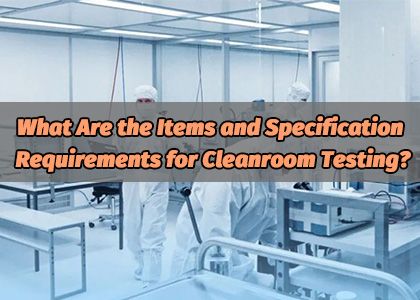
Q1:Cleanroom inspection for cleanliness check
1. A cleanroom is a room that controls the concentration of particles in the air.
2. When using them or during construction, the induction, generation and retention of particles in the room should be reduced.
3. Other related indoor parameters, such as temperature, humidity and pressure, also need to be controlled.
4. The clean area is a limited space that controls the concentration of suspended particles in the air.
5. The design or construction and use of the space should reduce the introduction, generation and retention of particles in the space.
6. Some related parameters in the space, such as temperature, humidity, pressure, etc., can be controlled according to various requirements.
7. Cleanroom inspection of the clean area can be either open or non-enclosed.
8. Cleanroom inspection of air cleanliness refers to the quantity and degree of dust particles in the air in a clean environment. The higher the dust concentration, the lower the cleanliness, and the lower the dust concentration. The latter has higher cleanliness.
9. The specific air cleanliness grade needs to be distinguished by using air cleanliness grades. Therefore, this level should be expressed by calculating the dust concentration in the air within the operating time. On the contrary, it is directly from encountering two low dust concentrations to not exceeding another high dust concentration, and this dust concentration range is used as the air cleanliness level.
Q2: What are the specifications of the cleanroom?
1. Evaluation of cleanroom environmental standards and engineering acceptance testing, including food, health supplements, cosmetics, milk, milk production workshops, electronic product production workshops, GMP workshops, hospital operating rooms, animal laboratories, biosafety laboratories, biosafety cabinets, ultra-clean workbenches, dust-free workshops, and sterile workshops.
2. The quantity of air changes, temperature and humidity, pressure difference, suspended particulate matter, airborne bacteria, settled bacteria, noise, illuminance, etc.
3. The cleanliness of the clean area is mainly achieved by introducing a sufficient amount of clean air to replace and dilute the particulate pollutants generated within the room.
4. The measurement of air supply volume, average wind speed, air supply uniformity, air flow direction and non-flow types of clean facilities and cleanrooms is extremely important.
Q3: Standard operating procedure for testing cleanliness of clean areas in clean rooms
1. Level 1 is applicable to the delivery and acceptance test under no-load conditions, while Level 4 is suitable for static or dynamic comprehensive performance tests.
2. In summary, several types of tests are applicable to situations where strict requirements for national temperature and humidity performance are imposed.
3. This test is specifically conducted after the uniformity of air flow test, such as adjustments to the air conditioning system, etc.
4. During this test, the air conditioning system is also fully operational, although all these conditions are stable.
5. Only humidity sensors are set in the humidity control areas, and the sensors are given sufficient stabilization time.
6. The measurement should be suitable for the actual usage purpose. After the sensors stabilize, the measurement will begin. The measurement time should be no less than 5 or two minutes.
7. The purpose of this test is to verify whether it is capable of maintaining the prescribed pressure difference in the constructed facilities and swimming pool water, as well as in each space within the facilities.
Q4: What are the cleanliness testing standards for the cleanroom inspection laboratory?
1. The current general cleanroom standards of a certain company are class 100,000, class 1000 and class 100.
2. Air flow speed and uniformity inspection. This kind of inspection is the basic detection or prerequisite for the effect of the cleanroom. The purpose of this kind of inspection is to clarify the operation of unidirectional flow cleanroom. Area or average air flow and uniformity.
3. Cleanroom inspection of indoor cleanliness or testing. Cleanliness inspection is to determine whether the clean environment can reach the level of air cleanliness. It can be tested using a particle counter.
Q5: What items need to be tested in the cleanroom inspection?
1. Occasionally, hospital operating rooms and wards also follow GMP requirements to conduct environmental tests on the cleanroom.
2. Instruments and equipment include laser particle counters, illuminance meters, digital sound level meters, environmental parameter detectors, intelligent anemometers, high-pressure sterilizers, constant temperature incubators, and aerosol samplers, etc.
3. The testing method and principle for suspended particulate matter in cleanroom inspection adopt the counting concentration standard.
4. By measuring the average number of suspended particles in the unit volume of air in the clean environment, the cleanliness level of suspended particles in the cleanroom is evaluated based on the number of suspended particles with a certain diameter or larger. Suspended particulate matter can produce light scattering under light or irradiation, and the intensity of the scattered light is proportional to the non-particle surface area.